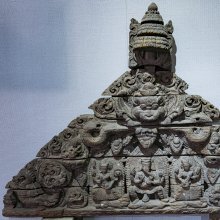Martyaloka, Martya-loka, Matryaloka: 8 definitions
Introduction:
Martyaloka means something in Hinduism, Sanskrit, Jainism, Prakrit. If you want to know the exact meaning, history, etymology or English translation of this term then check out the descriptions on this page. Add your comment or reference to a book if you want to contribute to this summary article.
Images (photo gallery)
In Hinduism
Vaishnavism (Vaishava dharma)
Source: Pure Bhakti: Brhad BhagavatamrtamMartyaloka (मर्त्यलोक) refers to:—Earth; planet of mortals. (cf. Glossary page from Śrī Bṛhad-bhāgavatāmṛta).

Vaishnava (वैष्णव, vaiṣṇava) or vaishnavism (vaiṣṇavism) represents a tradition of Hinduism worshipping Vishnu as the supreme Lord. Similar to the Shaktism and Shaivism traditions, Vaishnavism also developed as an individual movement, famous for its exposition of the dashavatara (‘ten avatars of Vishnu’).
Shaktism (Shakta philosophy)
Source: Google Books: ManthanabhairavatantramMartyaloka (मर्त्यलोक) [=Martyalokata?] refers to the “mortal world”, according to the Manthānabhairavatantra, a vast sprawling work that belongs to a corpus of Tantric texts concerned with the worship of the goddess Kubjikā.—Accordingly, “[...] In the beginning, the supreme Kubjā in her supreme form is Kālikā. This supreme energy has descended in order to grace the worlds. She came into the mortal world [i.e., martyalokata] as the division into the three lineages. In the lineage of the eldest, in the Transmission of the Aged that Kuleśvarī abides in a divine form and is enveloped by the twenty-seven depositions. Once one has learnt the iconic form of the lineages, one should deposit the sequence of the deposition. [...]”.

Shakta (शाक्त, śākta) or Shaktism (śāktism) represents a tradition of Hinduism where the Goddess (Devi) is revered and worshipped. Shakta literature includes a range of scriptures, including various Agamas and Tantras, although its roots may be traced back to the Vedas.
In Jainism
General definition (in Jainism)
Source: The University of Sydney: A study of the Twelve ReflectionsMartyaloka (मर्त्यलोक) refers to the “world of mortals”, according to the 11th century Jñānārṇava, a treatise on Jain Yoga in roughly 2200 Sanskrit verses composed by Śubhacandra.—Accordingly, “The doctrine is able to produce the happiness which is the best part of the city of the chief of the snakes. The doctrine is the great joy conveyed to the world of mortals (prāpita-martyaloka-vipulaprīti) for those possessing a desire for that. The doctrine is the place of the arising of the taste for the constant happiness in the city of heaven. Does not the doctrine make a man fit for pleasure with a woman [in the form] of liberation?”.
Synonyms: Manuṣyaloka.

Jainism is an Indian religion of Dharma whose doctrine revolves around harmlessness (ahimsa) towards every living being. The two major branches (Digambara and Svetambara) of Jainism stimulate self-control (or, shramana, ‘self-reliance’) and spiritual development through a path of peace for the soul to progess to the ultimate goal.
Languages of India and abroad
Sanskrit dictionary
Source: DDSA: The practical Sanskrit-English dictionaryMartyaloka (मर्त्यलोक).—the world of mortals, the earth; क्षीणे पुण्ये मर्त्यलोकं विशन्ति (kṣīṇe puṇye martyalokaṃ viśanti) Bhagavadgītā (Bombay) 9.21.
Derivable forms: martyalokaḥ (मर्त्यलोकः).
Martyaloka is a Sanskrit compound consisting of the terms martya and loka (लोक).
Source: Cologne Digital Sanskrit Dictionaries: Monier-Williams Sanskrit-English DictionaryMartyaloka (मर्त्यलोक):—[=martya-loka] [from martya > marta] m. = -bhuvana, [Kaṭha-upaniṣad; Mahābhārata etc.]
[Sanskrit to German]
Sanskrit, also spelled संस्कृतम् (saṃskṛtam), is an ancient language of India commonly seen as the grandmother of the Indo-European language family (even English!). Closely allied with Prakrit and Pali, Sanskrit is more exhaustive in both grammar and terms and has the most extensive collection of literature in the world, greatly surpassing its sister-languages Greek and Latin.
Kannada-English dictionary
Source: Alar: Kannada-English corpusMatryalōka (ಮತ್ರ್ಯಲೋಕ):—[noun] the earth, the world of human beings.
Kannada is a Dravidian language (as opposed to the Indo-European language family) mainly spoken in the southwestern region of India.
See also (Relevant definitions)
Partial matches: Loka, Martya.
Starts with: Martyalokata.
Full-text: Mrityuloka, Svastika, Martya, Vipulapriti, Kshina, Prapita, Manushyaloka, Martyalokata.
Relevant text
Search found 7 books and stories containing Martyaloka, Martya-loka, Matryaloka, Matryalōka, Martyalōka, Martya-lōka; (plurals include: Martyalokas, lokas, Matryalokas, Matryalōkas, Martyalōkas, lōkas). You can also click to the full overview containing English textual excerpts. Below are direct links for the most relevant articles:
Brihad Bhagavatamrita (commentary) (by Śrī Śrīmad Bhaktivedānta Nārāyana Gosvāmī Mahārāja)
Verse 1.2.14 < [Chapter 2 - Divya (the celestial plane)]
Verse 2.2.5 < [Chapter 2 - Jñāna (knowledge)]
Verse 1.3.54 < [Chapter 3 - Prapañcātīta (beyond the Material Plane)]
Kavyamimamsa of Rajasekhara (Study) (by Debabrata Barai)
Part 8.1 - Rājaśekhara’s concepts of the Universe < [Chapter 5 - Analyasis and Interpretations of the Kāvyamīmāṃsā]
Isha Upanishad (by A.C. Bhaktivedanta Swami Prabhupada)
Vastu-shastra (1): Canons of Architecture (by D. N. Shukla)
(iv.b) Aparājitapṛcchā (Subject-matter and Creation) < [Chapter 5 - Study of Hindu Science of Architecture]
The Devi Bhagavata Purana (by Swami Vijñanananda)
Prasthanatrayi Swaminarayan Bhashyam (Study) (by Sadhu Gyanananddas)
11. Ekāntiki Bhakti (Introduction) < [Chapter 4 - Analysis on the Basis of Spiritual Endeavour]
